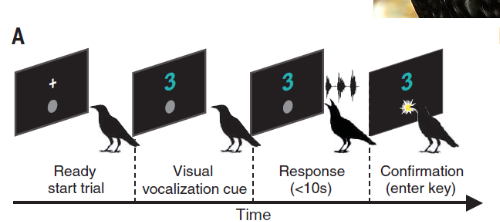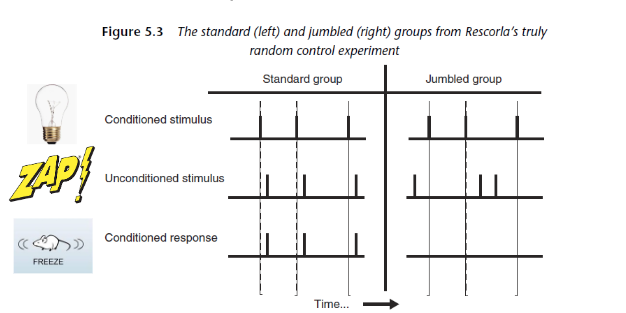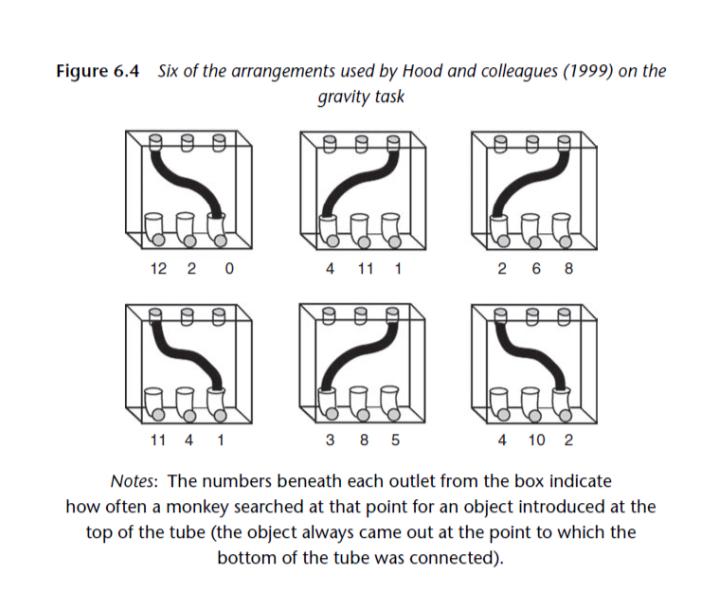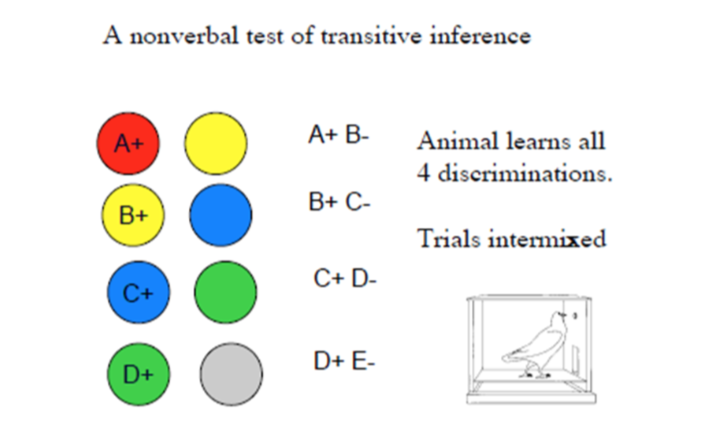Animal Cog Exam 2
1/48
There's no tags or description
Looks like no tags are added yet.
Name | Mastery | Learn | Test | Matching | Spaced |
|---|
No study sessions yet.
49 Terms
Zeitgeber “Time Giver”
a stimulus that helps entrain the sleep/wakefulness cycle
light, temp, social factors, availability of food
20 hours seems to be the lower limit on these cycles and 30 hours is the upper limit
biebach’s garden warbler study
birds can learn location of food that is available at limited times
birds can use circadian clock to judge the passage of time
short time intervals
gill (1988)
long-tailed hermit hummingbird:
males want to minimize foraging time, to maximize time spent impressing females
a naturally occurring time problem: flowers are not always full of nectar, but refill over time
the longer a bird waits between foraging, the higher the chance nectar has refilled, but also a higher chance that another bird has drained the flower
short time intervals: when artificial flowers are introduced that refill every 20 minutes, the birds soon adopt a schedule where they revisit after a bit more than 20 minutes
when refill schedule is switched to every 10 minutes, the birds soon adopt a schedule where they revisit after a bit more than 10 minutes
scalar timing (short time intervals)
church 1978: internal “ticks” counted in short term memory store; ticks in short term memory is compared with the number in long term memory from previous experience with the task
more or less judgements
McComb, Packer, & Pusey:
play sounds of roaring intruder lion or lions for prides of different sizes and observe responses (approach, stay, retreat)
Wilson, Hauser, & Wrangham:
play control sound (eagle/colobus cry)
.play pan-hoot of foreign male and observe reactions
-probability of group countercalling or approaching the call is dependent on nubmer of adult males in the group
relative number judgement
“which pile has more candy (more or less concept)?”
absolute number judgement
realizing that a pile of 5 starbursts has something in common with a pile of 5 sour patch kids
counting
applying a label for numerical groups
arithmetical operations
in order to count, you need a concept of relative number and a concept of absolute number
in addition, you need to recognize two more numerical ideas:
tagging - a number has a speciifc tag that goes with it: “one”
cardinality -
the tag for the last item in the set is the name for the number of items in the set
relative judgement (more or less)
Koehler:
pigeons can learn to choose smaller or larger number of grains in this task
they learn the task easier if there are values that are farther apart, rather than consecutive values
Emmerton:
Put pigeons in skinner boxed, were originally trained to discriminate between
many: 6 dots, 7 dots
few: 1 dot, 2 dots
Later tested on 3 and 5 dots and perform correctly
Emmerton also systematically varied elements of the stimuli-size, brightness, relative orientation
Emmerton’s results suggest that pigeons really do have relative number concepts like “fewer” or “many”
absolute judgement (5 items from one group have something in common eith 5 items from another group)
Davis and Albert, 1986:
Rocky the raccoon; rocky is given plastic cubes with varying numbers of items inside
only the boxes with 3 items in them were openable
Davis & Bradford, 1986:
train rats to take food from the third of six tunnels
All tunnels have food
Doors are locked to all but third
Tunnels moved around from trial to trial
with training, rats go directly to correct tunnel
“counting" studies
liau et al. (2024)
carrion crows:
the crows flexibly produce variable numbers of one to four vocalizations in response to arbitrary cues associated with numerical values
Alex and counting:
language is helpful when assessing counting skill
alex: model/rival technique
humans demonstrate the response
human is model: parrot sees human respond
human is rival: parrot wants attention of experimenter
Hunt et al. (2008)
number concepts in new zealand robins
food caching birds: often eat insects that are too large to eat all at once
hides pieces around habitat for winter
might need to keep track of how many food items are stored in a given location

Associative learning
learning about the relationship between two separate stimuli
conditioning: classical or operant
Ivan Pavlov
Famous experiments with dogs (“psychic secretions”)
Core components of classical conditioning
Unconditioned stimulus
Unconditioned response
Conditioned stimulus
Conditioned response
Classical conditioning - extinction
Classical conditioning - spontaneous recovery
Classical conditioning studies
Olson and Fazio -
Told to look for target amongst “random images and words”
In actuality, images are not totally random (one image associated with positive words/pictures, one associated with negative words/pictures)
later asked participants to rate how much they like different pokemon
-people liked pokemon that had been associated with positive images/words
Eric Kandel:
aplysia:
sea snail, only 20,000 neurons and only 2 neurons controlling tongue
gill withdrawal reflex - animal moves to protect gill with mantle if siphon is contacted
Hollis et al.:
Male gouramis need to protect territory to attract a mate
sometimes they are too aggressive and attack potential mates
can you condition these fish to not attack female gouramis?
10s exposure to white light, followed by 5 minutes of exposure to female fish
Light signals female fish is coming; as a result, more mating displays and less biting
Conditioned male fish have far more offspring
What is really learned in classical conditioning?
contiguity - closeness in time and space
Resclorla: the jumbled group does not learn, despite getting the same stimuli. what is missing? the pigeons in the jumbled condition get contiguity, but no contingency
Contingency - one stimulus necessarily follows the other

Classical conditioning is an evolved mechanism that enables animals to be sensitive to signals that are important in their lives
“Drongos in this study spent roughly a quarter of their time following meerkats. When a predator appears, the birds produce a distinct alarm call, and through paired association, meerkats learn this relationship and more successfully avoid predation by taking evasive action when they hear the drongos making their alarm call”
“while meerkats benefit when these birds alert them to the presence of predators, the birds benefit by periodically acquiring extra calories at the expense of the meerkats. However, there is a careful balance here. If the drongo alarm call happens too often in the absence of a predator, then the former association established through Pavlovian conditioning will break down as the conditioned stimulus (CS) no longer reliably predicts the presence of the unconditioned stimulus (US). This is called Respondent Extinction”
Boisseau, Vogel & Dussutour 2016
Slime molds:
Unicellular organism, sort of. No nervous system.
Learns to ignore a stimulus when the stimulus is repeated and spontaneously recovers when withheld for 2 days- habituation
also demonstrate stimulus specificity- the slime molds can learn the difference between quinine and caffeine
Instrumental/Operant conditioning
“The other side of the coin is the situation where an animal’s own behavior is the cause of an event in the environment – this is called instrumental conditioning. Instrumental conditioning (also known as Operant or Type II conditioning) is so called because the animal’s behavior is instrumental to obtaining some outcome.”
Positive reinforcement: environmental stimulus added, the behavior increases in rate
Negative reinforcement: environmental stimulus removed, the behavior increases in rate
Positive punishment: Environmental stimulus added, the behavior decreases in rate
Negative punishment: environmental stimulus removed, the behavior decreases in rate
Thorndike’s law of effect
responses that produce good effects will be repeated
responses that yield negative effects are less likely to be repeated
B.F. Skinner and Superstitious pigeons
According to skinner, a superstitious behavior is a behavior that is accidentally reinforced. Skinner places hungry pigeons in a skinner box and food is dispensed randomly. Pigeons begin exhibiting “superstitious” behavior
one pigeon happened to be turning to the left when the food is presented- learns to spin to the left
one pigeon thrusts head onto upper corner of box
two other pigeons learn to swing their upper bodies like pendulums
staddon & simmelhag 1971
replicate skinner; pigeon behavior is not random
pigeons all do mostly the same behavior— peck at the food magazine
an action that is appropriate for trying to get food
What is learned in operant conditioning?
Contiguity - timing is very important in operant conditioning, an interval of 2 secoonds between action and consequence can be too long for learning to occur
Contingency - reliable dependency of one event upon another.
When rewards are not delivered consistently, learning slows
Can learn more complex relationships between stimuli too
-e.g., reward is only available under specific conditions
-discriminative stimulus:
e.g., lever pressing is only rewarded when a light is on, treat pocuh presence
Dorey, Rosales-Ruiz, Smith, & Lovelace, 2009
Rafiki, olive baboon, engaging in self-injurious behavior (hair pulling, biting)
baseline: keeper warn rafiki not to hurt herself when engagin in SIB
treatment condition: reinforce alternative behavior such as lip smacking “you look so pretty today” and ignore self injurious behavior
“keepers were instructed to ignore Rafiki’s biting and hair pulling (placing it on extinction) and instead Differentially Reinforce an Alternative behavior (DRA+), lip smacking, by providing attention in the form of brief compliments, such as “You look pretty today” when it occurred. As predicted, the percent of time Rafiki spent engaged in self-injury dropped almost to nothing when she no longer received keeper attention for this behavior. Instead, the amount of time she spent engaging in the new healthy behavior, lip smacking, increased, allowing her to gain the extra attention she found so reinforcing without continued health risk.”
Innate limits on classical/operant conditioning
when conditioning was introduced, it was thought that any stimulus coud easily be paired with any response “all learning is equally probable under the right circumstances”
however, subsequent research has revealed limitations
conditioned taste aversion:
garcia notes that rats don’t drink from water they previously got sick from
rats learn associations between tastes and illness very fast- often in one trial
this suggests that some associations are easier to learn than others
Garcia & Koelling, 1965
rats exposed to “bright noisy” water or sweetened water
subsequently, some rats exposed to shock, some to brief xray
-xray enduces nausea
“although white rats can easily learn that certain taste cues wil be followed by sensations of nausea, and that certain sounds will be followed by skin pain caused by shock, they have greater difficulty forming associations between taste and consequent skin pain or between sound and subsequent nausea”
“people and other animals have great difficulty learning that a light or sound is going to make them sick. It makes perfect sense – we are born prepared by evolution to learn that flavors can warn of sickness, but we are unprepared to learn that a sight or sound could be warning us about sickness, even though we can learn many other things about
sights and sounds.”
“evolutionary predispositions not only influence how animals initially respond to potentially hazardous stimuli but can also influence how readily they learn new associations through personal or social experiences”
Lorenz & Tinbergen, 1948
turkey chicks
hawk v. goose figure
chicks more fearful of the hawk model than the goose model
innate fearfulness of some stimuli over others
“Tinbergen discovered that newly hatched turkey chicks with no prior experience would crouch in fear when some overhead objects cast a shadow over them. Using models, he found that they were especially sensitive to the shape of a hawk, running for cover and screeching in fear when presented with this stimulus”
“There appear to be certain fears that many members of a species share, and research suggests that while specific fears may still be learned through associative conditioning, animals may be predisposed to acquire fear or aversions towards some stimuli more easily than others.”
Keller and Marion Breland
Animals are not “tabula rasa,” instinctive drift
when project pigeon is defunded, these former students of skinner go into business applying skinner’s ideas
Animal behavior enterprises: train pigs to put coins in banks for tv commercials,etc
“This particular problem developed in pig after pig, usually after a period of weeks or months, getting worse every day. At first the pig would eagerly pick up on dollar, carry it to the bank . . . but eventually, on the way back, instead of carrying the dollar and depositing it, he would repeatedly drop it, drop it again, root it along the way . . . etc”
Rocky the raccoon - “Eventually . . . Rocky not only dipped and clung to the coins as before but also rubbed them together for minutes on end, even though this behavior was never reinforced. What the Brelands had unwittingly tapped into was the natural feeding repertorie of raccoons.”
Instinctive drift
refers to an animal’s tendency to drift away from what is currently being learned back toward its initial or predisposed response to a stimulus.
Reasoning
“adapt thought or action to some end”
-flexibility of response
-integration of info and drawing conclusions baesd on info that is not immedaitely available to the senses
Fixed action patterns
Fixed action patterns are reliably elicited by releasing stimuli
Rigid, predictable, and highly-structured sequences
Once triggered, will continue to completion
(e.g., egg retrieval in greylag goose: continues dragging motion even if egg is taken away)
Antlion larvae & tool use
What should count as tool use?
Antlion larvae excavate funnel shaped pits to trap prey; if prey tries to escape teh antlion throws sand at it to impede escape… is this tool use? Is it reasoning?
Not flexible to differing circumstances, not integrating info; not reasoning, more like a fixed action pattern
“These larvae are called ant-lions because of their aggressive character. To capture prey, ant-lions make use of the soil in which they live. They excavate a funnel-shaped pit in suitably soft earth. When prey falls in the pit, the ant-lion tries to grab it and eat it. If the unfortunate animal so captured tries to escape up the side of the pit, the ant-lion will shower it with sand by rapid head and mandible movements in an attempt to hinder its escape. Fascinating as this behavioral pattern certainly is, there is no suggestion that this behavior can be flexibly adapted to circumstances. There is no integration of information going on here that would fit any definition of reasoning.”
Flexibility
some definitions of tool use by animals require “flexibility:”
-animals must transport, modify, or select the tool in a way that illustrates awareness of the relationship between the object and the task
Hall & Schaller, 1964: observe that sea otters hold onto the same rock to use to open mussels. implies some foresight (?) planning to use the rock again for the next mussel
Taylor & Gray, 2012: New caledonian crow, food near potentially dangerous stimuli. Crows have access to stick, but food is within easy reach. When do they choose the stick? Crows weighed the potential danger of the situation and changed their tool use based on these assessments
“Crows were more likely to use a stick when confronted with a novel object (the snake or teddy bear) than when confronted with a familiar one (a food bowl). However, crows on average were most likely to pick up a stick when confronted with a model snake, resembling a natural predator, than when confronted with a teddy bear or food bowl. This suggests that crows may take the potential for danger into account when choosing to utilize tools to retrieve food items, in addition to the food item’s accessibility”
Brooks, 1988: hermit crabs placed in tank with an octopus. Prior to release of the octopus, crabs are allowed to place 0, 1, or 3 anemones on their shells. Crabs that attach anemones survive longer- tool use helps them survive.
Insight
Wolfgang Kohler (1925):
Waiting on blockage. Chimpanzees - block stacking problem, two stick problem
“all six apes vainly endeavored to reach the fruit by leaping up from the ground. Sultan soon relinquished this attempt, paced restlessly up and down, suddenly stood still in front of the box, seized it, tipped it hastily toward the objective, but began to climb upon it at a horizontal distance, and springing upwards with all his force, tore down the banana”
Visalbergi & Limongelli (1994)
Tufed capuchins, trap tube test
Only RB learned to effectively choose the correct side of the trap tube
“A treat was placed in either the right or left end of the tube, and the monkey provisioned with a stick of just the right thickness to push through the tube and dislodge the treat. If the monkey pushed the treat out either end of the tube, then it was allowed to consume it. If, however, the monkey pushed the treat so that it fell down the hole in the middle, it was lost to the monkey on that trial. In the course of over 140 trials of testing, only one of the four monkeys learned to push the treat consistently from the direction that ensured it would come out of the end and not fall down the “trap.””
Hood (1999)
Cotton top tamarins
“Hood developed a very simple task. Cotton top tamarins were shown objects being dropped down an opaque tube in the apparatus. There were three points at the top of the box where the tube could be connected, and another three outlet points at the bottom of the box. The crucial feature of this apparatus was that the tube never connected an opening at the top of the box to an outlet directly beneath it. Thus, an object dropped through one of the openings at the top would never come out the hole directly below the place where it had been inserted. The tamarins failed to learn this, and seldom chose the outlet to which the opaque tube was connected. Instead, they often looked directly below the opening where the object had been dropped, following the path – that in the absence of the tubes, rerouting – would have been established by gravity.”
The cotton top tamarins fail to learn that the object doesn’t drop straight down

Transitive inference
Deducing new relationships from stated relationships
Pigeons: nonverbal test of transitive inference, when presented with a new choice they reliably choose the correct answer.
“Here too, when tested on the critical second and fourth items from the implied series of stimuli, the pigeons chose correctly.”

Tibbetts et al., 2019
Wasps v. honeybees: similar nervous systems, but worker honeybees do not have extensive social striation.
Wasps live in complex socially constructed hierarchies.
Honeybees cannot learn this task, but wasps can
Teach wasps transitive inference hierarchy
-colors associated with shock/safety
-why can wasps do this but not bees?
tracking social hierarchies is a form of transitive inference problem; generally, species that have hierarchies perform well on this task
Social complexity hypothesis:
the social complexity hypothesis asserts that animals living in large social groups should display enhanced cognitive abilities along predictable dimensions; transitive inference is one of these dimensions
“The ability to form transitive inferences enables an animal to form rankings, and the need to form rankings is quite widespread in many species. Many social animals, for example, need to be aware of the hierarchy within their group. Figuring out who is dominant to whom is a process fraught with possibly dangerous interactions.”
Bond, Kamil, & Balda, 2003:
pinyon jays (more social) v. scrub jays (social unit much smaller)
“the pinyon jays are better at the task. support for the social complexity hypothesis”
“evidence has been found that at least some species, such as pinyon jays, can and do use transitive inference to weigh their own dominance ranking against others in their social environment, lending further support to on important predicted evolutionary function for this skill”
Fairness
DeWall:
Sarah Brosnan and Frans de Waal (2003) conducted a series of studies to assess how capuchin monkeys would respond to receiving less preferred rewards than a companion under a number of different conditions (grape vs. cucumber).”
“researchers found that subjects were less likely to exchange a token for a lower valued food (cucumber) when they witnessed their companion receiving a higher valued food (grape) for the same action.”
A capuchin rejects a cucumber when her partner is offered a grape— is she protesting the unfairness, or is she just holding out for the grape?
Inequity aversion
Contends that subjects track and compare their reward scheme with that of their partner
species that do not share resources such as territory, food, or support during conflict, also do not show refusal behavior akin to that shown by capuchin monkeys
frustration hypothesis
a subject’s past experience in receiving a preferred reward for a task creates an expectation to receive this reward
in original experiment (grapes and cucumbers), monkeys served as both subejcts and partners
Food expectation hypothesis
Sight of the high value food creates expectation
Range et al., 2008
Dogs were sensitive to reward inequity but not other types of inequity
Social cognition definition
Cognitive processes devoted to learning about and interacting with other individuals
Usually conspecifics (a member of your own species)
The most interesting social cognition usually emerges in species that form stable hierarchical groups
Thinking about the relation between the self and others within the group
Mirror recognition task
Developed by gordon gallup jr; a nonverbal test of self awareness
scoring the mirror task:
social responses
-physical inspection (e.g., looking behind the mirror)
-repetitive mirror-testing behavior
-contingency testing
Realization of seeing themselves: self directed behavior (grooming, etc)
Gallup (1970)
wildborn chimps, living in captivity
given access to mirror for 10 days
anesthetize chimps, paint brow, ear
“mark test”
chimps passed the mark test; can use the mirror to find marks, argued that chimps have a sense of self
“In Gallup’s test, the animal is first anesthetized. While it is sleeping, its forehead and ear are marked with dots of non-irritating ink. Once they awake, the animals show no awareness of the ink dots until they see themselves in a mirror, at which point they may touch them on their own body. Touching the mark on their own bodies in this way indicates that they recognize the mirror image as being themselves. Chimpanzees, orangutans, and (possibly) a gorilla have all passed Gallup’s mark test”